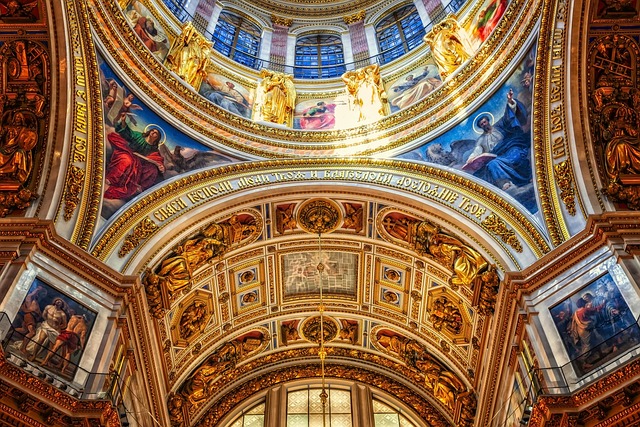There are currently 23 Eastern Catholic Churches in communion with the Roman Catholic Church. These churches are of the Byzantine, Alexandrian, Antiochian, Armenian, and Chaldean traditions.
Table of Contents
The Byzantine Catholic Church: A Brief Overview
The Byzantine Catholic Church is a unique branch of the Catholic Church that follows the Byzantine Rite, which originated in the Eastern Roman Empire. This church is in full communion with the Bishop of Rome, also known as the Pope, and is considered one of the Eastern Catholic Churches.
The Byzantine Catholic Church has its roots in the early Christian communities of the Byzantine Empire, which was centered in Constantinople (modern-day Istanbul). These communities developed their own liturgical traditions and practices, which were influenced by the Greek language and culture. Over time, these traditions spread to other parts of the Byzantine Empire, including Eastern Europe.
One of the distinguishing features of the Byzantine Catholic Church is its use of the Byzantine Rite in its worship services. This rite is characterized by its rich and elaborate liturgical ceremonies, which include the use of incense, icons, and chant. The liturgy is conducted in the vernacular language of the local community, but the prayers and hymns are often sung in ancient Greek or Church Slavonic.
The Byzantine Catholic Church also has its own hierarchy of bishops, priests, and deacons, who are ordained according to the Byzantine Rite. The head of the church is known as the Metropolitan, who is responsible for overseeing the spiritual and administrative affairs of the church within a particular region. The Metropolitan is appointed by the Pope and is in communion with him.
In terms of theology, the Byzantine Catholic Church shares many beliefs and practices with the Roman Catholic Church. It accepts the teachings of the seven ecumenical councils, which defined the core doctrines of Christianity, including the nature of Christ and the Trinity. It also recognizes the authority of the Pope as the successor of St. Peter and the head of the universal church.
However, there are some differences between the Byzantine Catholic Church and the Roman Catholic Church. One of the most notable differences is the use of icons in worship. Icons are religious images that are venerated by the faithful as windows into the divine. They are often used in the liturgy and are considered an important part of Byzantine spirituality.
Another difference is the practice of fasting. In the Byzantine Catholic Church, fasting is seen as a spiritual discipline that helps believers to grow closer to God. Fasting periods are observed throughout the liturgical year, including Great Lent, which is a forty-day period of fasting and prayer leading up to Easter.
Despite these differences, the Byzantine Catholic Church is fully in communion with the Roman Catholic Church. This means that Byzantine Catholics can receive the sacraments, such as the Eucharist and confession, in Roman Catholic churches, and vice versa. It also means that Byzantine Catholics are in full communion with the Pope and accept his authority as the successor of St. Peter.
In conclusion, the Byzantine Catholic Church is a unique branch of the Catholic Church that follows the Byzantine Rite. It is in full communion with the Pope and shares many beliefs and practices with the Roman Catholic Church. While it has its own distinct traditions and customs, it is an integral part of the universal Catholic Church.
Understanding the Relationship Between the Roman Catholic Church and the Ukrainian Greek Catholic Church

The relationship between the Roman Catholic Church and the Ukrainian Greek Catholic Church is a complex and fascinating one. Both churches share a common faith in Jesus Christ and are part of the larger Christian tradition, but they have distinct histories and traditions that have shaped their relationship with each other and with Rome.
The Ukrainian Greek Catholic Church, also known as the Ukrainian Catholic Church, is one of the Eastern Catholic Churches in communion with Rome. This means that while it follows the Byzantine Rite and has its own unique liturgical practices, it recognizes the authority of the Pope and is in full communion with the Roman Catholic Church.
The Ukrainian Greek Catholic Church traces its roots back to the 9th century when Christianity was first introduced to the region that is now Ukraine. Over the centuries, the church developed its own distinct traditions and liturgical practices, blending elements of Eastern Orthodoxy with the teachings of Rome. However, its relationship with Rome has not always been smooth.
During the 16th century, the Ukrainian Greek Catholic Church faced persecution and suppression by both the Orthodox Church and the Roman Catholic Church. At times, it was forced to go underground and practice its faith in secret. It was not until the 19th century that the church began to experience a revival and gain more recognition.
In 1596, the Union of Brest was signed, which brought the Ukrainian Greek Catholic Church into communion with Rome. This union allowed the church to maintain its Eastern traditions and liturgy while recognizing the authority of the Pope. However, not all members of the church accepted this union, and a split occurred, leading to the formation of the Ukrainian Orthodox Church.
Today, the Ukrainian Greek Catholic Church is the largest Eastern Catholic Church in the world, with millions of faithful followers. It has its own hierarchy and structure, with a Major Archbishop as its head. The church is known for its rich liturgical traditions, including beautiful iconography and elaborate ceremonies.
The relationship between the Roman Catholic Church and the Ukrainian Greek Catholic Church has had its ups and downs over the years. In the past, there have been tensions and disagreements, particularly over issues of jurisdiction and the role of the Pope. However, in recent decades, there has been a renewed effort to foster closer ties and promote unity between the two churches.
Pope John Paul II played a significant role in improving relations between the Roman Catholic Church and the Ukrainian Greek Catholic Church. He visited Ukraine in 2001, becoming the first Pope to do so, and expressed his support for the church and its faithful. Since then, there have been ongoing efforts to promote dialogue and understanding between the two churches.
In conclusion, the relationship between the Roman Catholic Church and the Ukrainian Greek Catholic Church is a unique and complex one. While they have distinct histories and traditions, they share a common faith in Jesus Christ and are in communion with each other. The Ukrainian Greek Catholic Church has faced challenges and persecution throughout its history, but it has remained steadfast in its commitment to its Eastern traditions and its unity with Rome. Through ongoing dialogue and understanding, the hope is that the relationship between these two churches will continue to grow and strengthen in the years to come.
Exploring the Communion Between the Roman Catholic Church and the Melkite Greek Catholic Church
The communion between the Roman Catholic Church and the Melkite Greek Catholic Church is a fascinating topic to explore. Both churches are part of the larger family of Orthodox churches, but they also have a unique relationship with Rome. In this article, we will delve into the history and current state of this communion, shedding light on the shared beliefs and practices that bind these two churches together.
To understand the communion between the Roman Catholic Church and the Melkite Greek Catholic Church, it is important to first grasp the concept of the Orthodox Church. The Orthodox Church is a collective term for the various Christian churches that trace their origins back to the early Christian communities in the Eastern Mediterranean. These churches share a common faith and liturgical tradition, but they are not under the authority of the Pope in Rome.
The Melkite Greek Catholic Church is one of the many Orthodox churches that have entered into communion with Rome. This church traces its roots back to the early Christian communities in the Middle East, particularly in Syria and Lebanon. Like other Orthodox churches, the Melkite Greek Catholic Church has its own hierarchy and liturgical traditions, but it also recognizes the authority of the Pope.
The communion between the Roman Catholic Church and the Melkite Greek Catholic Church has its roots in the historical events of the 16th century. During this time, the Orthodox Church in the Middle East faced significant challenges from the expanding Ottoman Empire. Many Orthodox Christians in the region sought protection from the Catholic Church, which led to the establishment of Eastern Catholic churches, including the Melkite Greek Catholic Church.
Despite their communion with Rome, the Melkite Greek Catholic Church maintains its distinct identity and traditions. The church follows the Byzantine Rite, which is characterized by its rich liturgical music and elaborate rituals. The Melkite Greek Catholic Church also has its own hierarchy, with a patriarch at its head. This patriarch is in communion with the Pope, but he also exercises authority over his own church.
The communion between the Roman Catholic Church and the Melkite Greek Catholic Church is not without its challenges. Like any relationship, there have been disagreements and tensions over the years. However, both churches have made efforts to foster dialogue and understanding, recognizing the importance of unity in the face of common challenges.
In recent years, there have been positive developments in the communion between these two churches. Pope Francis has been particularly committed to promoting dialogue and reconciliation with the Orthodox churches. His visit to the Ecumenical Patriarch of Constantinople in 2014 was a significant step towards strengthening the bonds between the Roman Catholic Church and the Orthodox churches, including the Melkite Greek Catholic Church.
In conclusion, the communion between the Roman Catholic Church and the Melkite Greek Catholic Church is a unique and important relationship within the larger family of Orthodox churches. Despite their differences, these two churches share a common faith and recognize the authority of the Pope. Through dialogue and understanding, they continue to work towards greater unity and cooperation, recognizing the importance of their shared heritage and the challenges they face together.
The Maronite Catholic Church: A Unique Communion with Rome
The Maronite Catholic Church is a unique communion with Rome that holds a special place within the Orthodox Churches in communion with the Holy See. With its rich history and distinct traditions, the Maronite Church offers a fascinating glimpse into the diversity of the Catholic faith.
Originating in the mountains of Lebanon, the Maronite Church traces its roots back to the fourth century when Saint Maron, a hermit monk, established a monastic community. Over time, this community grew and developed its own distinct liturgical practices and spiritual traditions. Today, the Maronite Church remains deeply connected to its Lebanese heritage while also embracing its role as a member of the Catholic Church.
One of the defining features of the Maronite Catholic Church is its liturgy. The Maronite liturgy is known for its vibrant and expressive nature, incorporating elements of both Eastern and Western traditions. The celebration of the Eucharist, or Mass, is central to Maronite worship, and it is characterized by beautiful chants, incense, and a deep sense of reverence. The Maronite liturgy is a testament to the Church’s commitment to preserving its unique identity while remaining in communion with Rome.
Another distinctive aspect of the Maronite Catholic Church is its governance. Unlike other Eastern Catholic Churches, the Maronite Church has its own patriarch, who serves as the spiritual leader of the community. The current patriarch, Bechara Boutros al-Rahi, is the 77th successor of Saint Maron and plays a crucial role in guiding the Maronite Church. This unique structure allows the Maronite Church to maintain its autonomy while still being in communion with the Pope.
The Maronite Catholic Church also has a strong devotion to the Virgin Mary. Mary, the Mother of God, holds a special place in Maronite spirituality, and her intercession is sought by many faithful. The Maronite Church celebrates several feasts dedicated to Mary throughout the year, including the Feast of the Annunciation and the Feast of the Assumption. These celebrations are marked by prayer, processions, and a deep sense of joy and gratitude for Mary’s role in salvation history.
In addition to its rich spiritual traditions, the Maronite Catholic Church is also known for its commitment to education and social justice. Throughout history, Maronite monasteries and schools have played a vital role in preserving knowledge and promoting literacy. Today, the Maronite Church continues to prioritize education, with many schools and universities under its patronage. Furthermore, the Maronite Church actively engages in charitable work, providing assistance to those in need and advocating for social justice.
The Maronite Catholic Church is a vibrant and dynamic communion with Rome that offers a unique perspective on the Catholic faith. Its rich history, distinct liturgy, and strong devotion to Mary make it a fascinating branch of the Catholic Church. Whether through its vibrant worship, its commitment to education, or its dedication to social justice, the Maronite Church continues to inspire and enrich the lives of its faithful. As a member of the Orthodox Churches in communion with Rome, the Maronite Catholic Church serves as a reminder of the beauty and diversity within the Catholic faith.
Conclusion
The Orthodox churches that are in communion with Rome are the Eastern Catholic Churches, also known as the Eastern Catholic Churches in full communion with the Holy See. These churches maintain their own distinct liturgical and spiritual traditions while recognizing the authority of the Pope.
For licensing reasons, we must provide the following notice: This content was created in part with the help of an AI.


